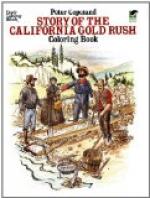Then came the gold fever, and nearly every one left town to go to the mines. Many people sold all they had to get money to buy mining tools and food enough to live on till they struck gold. Men started for the mines, leaving their houses and stores alone with no one to care for goods or furniture.
But news of the finding of gold had reached other places, and soon ships from the Atlantic coast, Mexico, and all over the world began sailing into San Francisco Bay. In ’49 the first steamer, the California, arrived from New York, and soon five thousand people were in San Francisco, where most of the supplies for the gold-fields had to be bought. Many of the newcomers lived in canvas tents or brush-covered shanties scattered about in the high sand-hills or in the thick chaparral. Some houses were built of adobe bricks, and the two-story frame Parker House was thought to be so fine that it rented for fifteen thousand dollars a month. Some wooden houses were brought out from the East in numbered pieces, like children’s blocks, to be put together here, and others thought to be fireproof were of iron plates made in the East.
The first public school was opened in ’48 and in the same building church services were held Sundays. The first post-office was in a store at the corner of Washington and Montgomery streets in ’49. By 1850 the city had five square miles of land that had been cut down from sand-hills or filled in on the mud-flats. The houses along the city-front were built on piles, and the tide ebbed and flowed under them. Long wharves for the unloading of ships ran out into deep water. At Jackson and Battery streets a ship was used for a storehouse, and after the earth was filled in this stranded vessel was left standing among the houses. On Clay and Sansome streets the old hulk Niantic had a hotel upon her decks, and the first city prison was in the hold of the brig Euphemia.
[Illustration: INDIAN BASKETS.]
While most of the miners were steady, hard-working men, honest, and very kind and generous to each other, some drank and gambled their hard-earned gold-dust away with a get of men who were ready to do any wrong thing for money. The gamblers and bad characters grew so troublesome by ’51 that the police could do little or nothing with them. Every day some one was robbed, or murdered, and thieves often set fire to houses that they might plunder. As the judges and police could not control these criminals, nearly two hundred good citizens formed a “vigilance committee.” It was agreed that bad characters should be told to leave town, and that robbers and murderers should be punished by the committee. Not long after, the vigilance committee hanged four men, and roughs and law-breakers left town for the mines. Men soon learned to keep the laws and do right.




